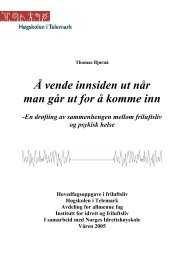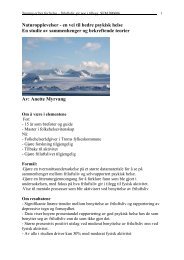Green Care: A Conceptual Framework - Frisk i naturen
Green Care: A Conceptual Framework - Frisk i naturen
Green Care: A Conceptual Framework - Frisk i naturen
Create successful ePaper yourself
Turn your PDF publications into a flip-book with our unique Google optimized e-Paper software.
References<br />
Antonovsky A. (1987) Unravelling the Mystery of Health. How People Manage Stress and Stay Well.<br />
San Francisco: Jossey-Bass.<br />
Bugental, J. F. T. (1964) ‘The third force in psychology’. Journal of Humanistic Psychology, 4, 19-25.<br />
Csíkszentmihályi, M. (1996) Creativity: Flow and the Psychology of Discovery and Invention. New<br />
York: Harper Perennial.<br />
Deci, E. L. and Ryan, R. M. (1985) Intrinsic Motivation and Self-determination in Human Behaviour.<br />
New York: Plenum Publishers.<br />
Deci, E. L. and Ryan, R. M. (2000) ‘The ‘what’ and ‘why’ of goal pursuits: Human needs and the selfdetermination<br />
of behavior’. Psychological Inquiry, 11, 227-268.<br />
Frankl, V. (1959) Man’s Search for Meaning (2006 edition). Boston, Massachusetts: Beacon Press.<br />
Maslow. A. H. (1971). Towards a Psychology of Being, Rotterdam, Netherlands: Lemniscaat.<br />
6.9 Salutogenic theory<br />
Salutogenesis is the process of factors which contribute to a person’s health,<br />
as opposed to processes behind illness, disease and sickness (pathogenesis).<br />
Salutogenetic theory was developed by Aaron Antonovsky from his study<br />
of concentration camp survivors of the second world war. His project<br />
came to study and to measure people’s orientation towards health rather<br />
than their orientation towards sickness and symptoms. From this point<br />
of view, he developed a new way of thinking about health and sickness<br />
i.e. “Salutogenic Thinking” (Antonovsky, 1979; Antonovsky, 1987) in<br />
contrast to traditional medical pathology and pathogenic orientation and<br />
thinking. Antonovsky further stressed that the dimension of health must<br />
be understood within the dimension of age, and within the social and<br />
cultural context (Antonovsky, 1985). In this perspective he introduces the<br />
phenomenon he called “the sense of coherence”, and underlines in his<br />
theories the vital importance of this dimension in a health and quality of<br />
life perspective (Antonovsky and Sagy, 1986). According to Antonovsky,<br />
human beings will throughout life always strive for coherence and<br />
wholeness.<br />
In his first book “Health, Stress and Coping”, Antonovsky (1979) presents<br />
an operationalised definition of health called “Sense of Coherence”<br />
measurable with the Sense of Coherence Scale (SOC). This was developed<br />
in the purpose of measuring health within a perspective of salutogenic<br />
thinking (Antonovsky, 1984). The Sense of Coherence is again broken<br />
81















